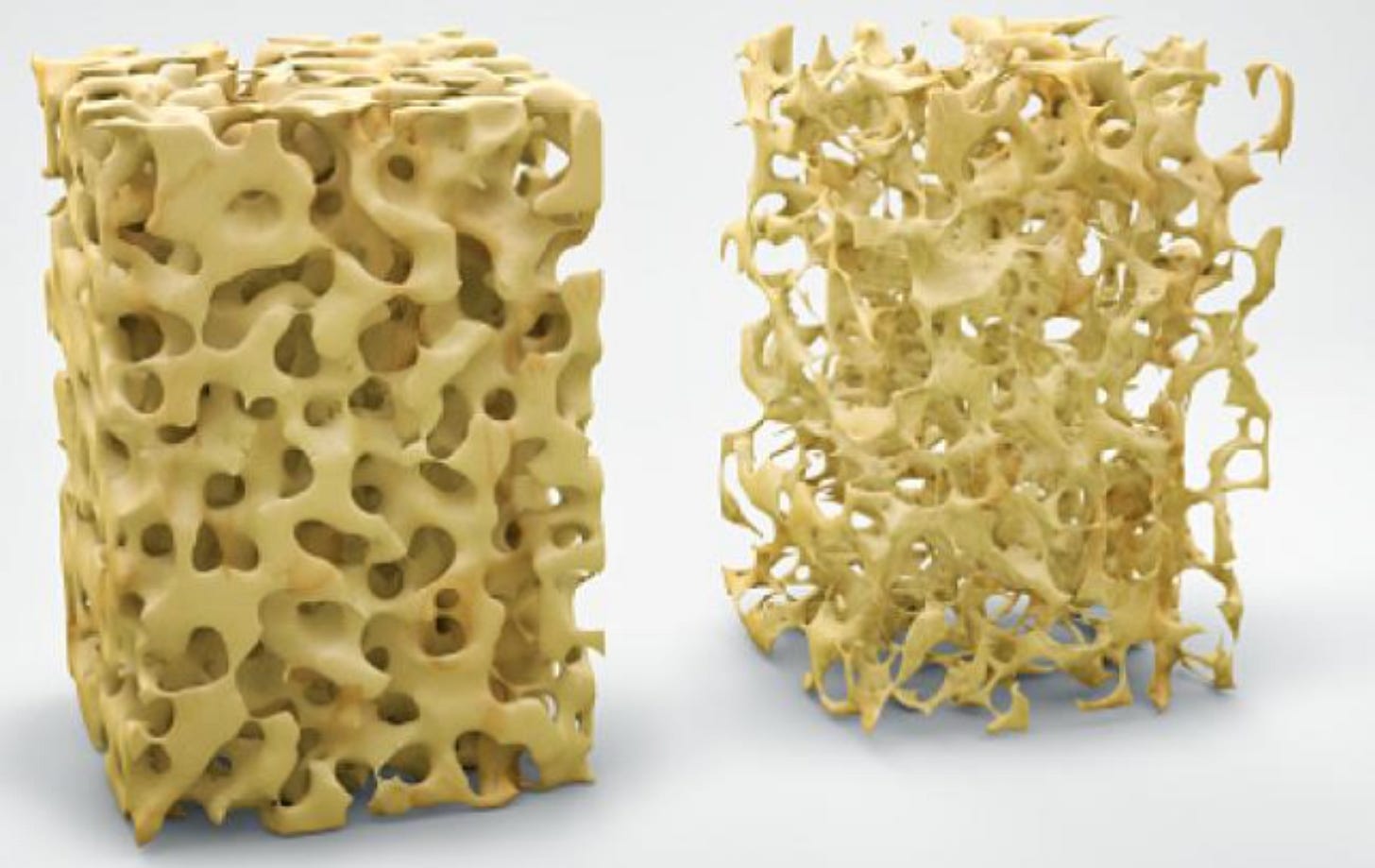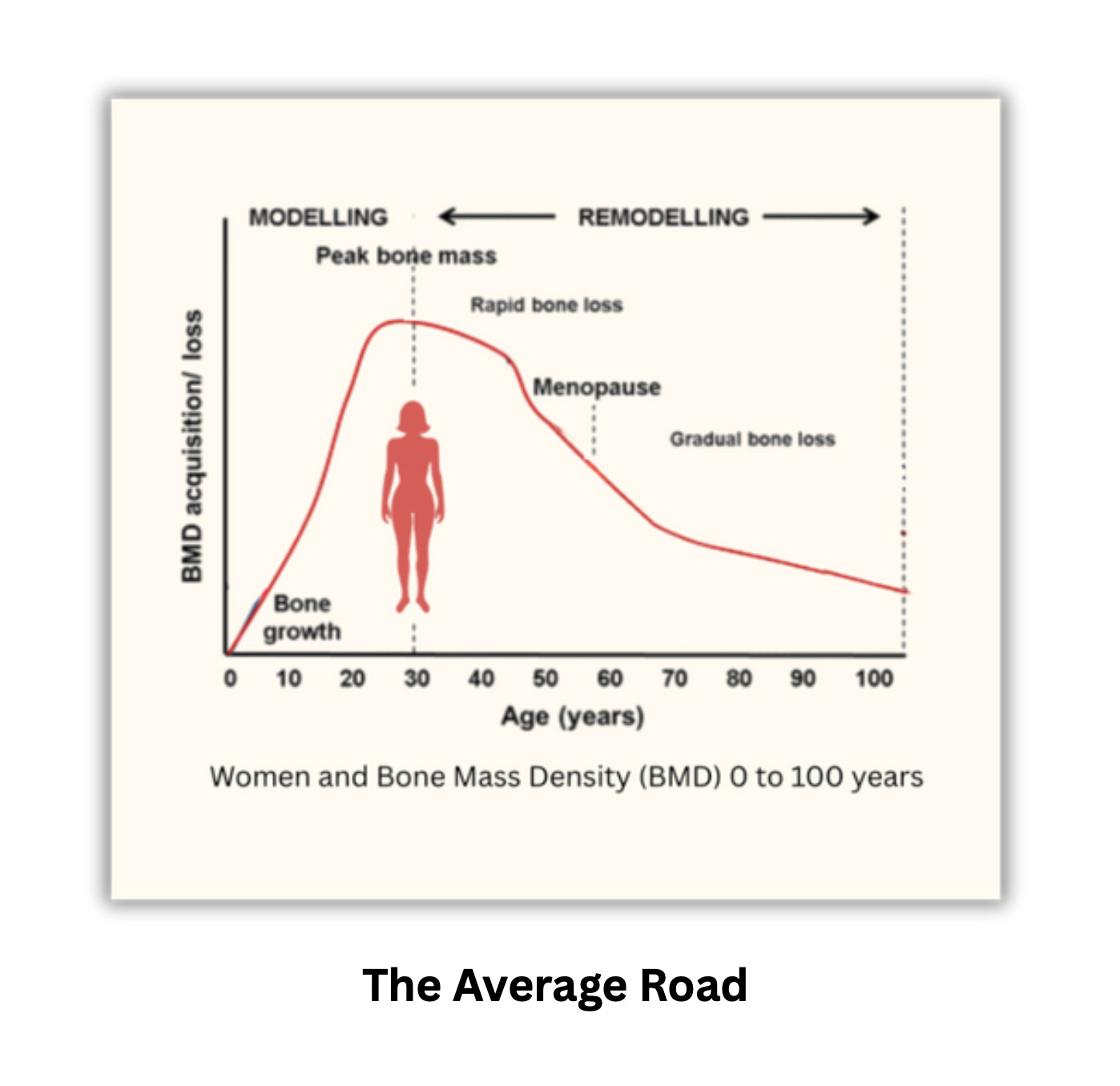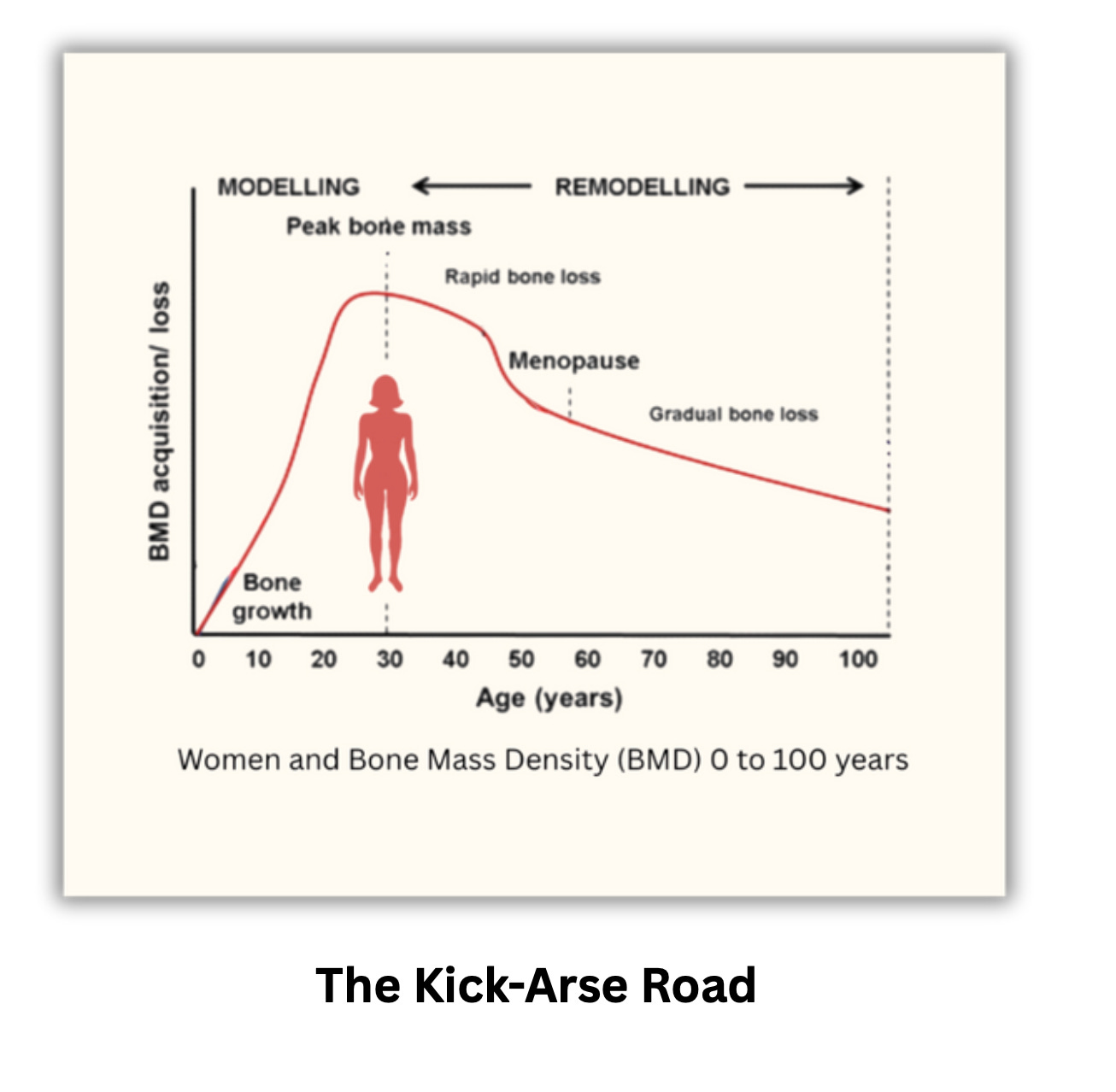Boss Your Bones After 50: Your journey to stronger bones starts here!
Our exciting new series starts here. PLUS The study that changed everything.
"Bones. They’re literally the backbone of our health, and our joy. To nurture and strengthen them is perhaps the ultimate act of self care.”
Road Trip to Younger is the go-to guide to healthy ageing for women over 50
After nearly 30 years as a journalist and magazine editor, I’m here, with healthy longevity as my ‘beat’ — cutting through the hype, decoding the science (so you don’t have to), and laying out your easy-to-follow roadmap. Destination: Joyspan—the longest, healthiest and most pleasurable lifespan possible.
We’re the community of women growing younger as we grow (gloriously) older.
A big welcome to our new subscribers. It’s wonderful to have you here!
OUR EXCITING NEW SERIES
Boss Your Bones After 50
Recently in our Move Your Body series – we laid out a 5-part roadmap for exercise as the ultimate longevity medicine for women 50+.
Now we're getting even stronger…
And this one's a time bomb!
With recent devastating predictions that one in two postmenopausal women will develop osteoporosis, Boss Your Bones After 50 brings together everything I’ve learned from my own experience fighting osteoporosis, as well as all the tools and know-how you need to dodge the statistics.
And dodge them, you can!
Osteoporosis may be one of the most debilitating diseases we can face after 50, but it's also one of the most preventable and solvable. And it all starts here!
It's hard to believe it was nine years ago this week.
It started with a fairly half-hearted jog around the block, one winter evening when I stepped off the footpath to let a more enthusiastic runner pass. It felt like the world had spun 360°—in fact it was my ankle that had done the spinning. An excruciating spiral fracture.
With both hands needed on crutches for several months, I couldn't even carry a plate or cup. I can't count the times I had to eat dinner in front of an open fridge—it doesn't get much sadder than that.
And then there was the shock of the osteoporosis diagnosis, at 55.
But for all the pain, nine years down the track, I call my fracture my 'lucky break'. It gave me a life mission: to never again lose my freedom and independence. And to make sure others — especially women 50+, just like you — don’t lose theirs.
What drives that mission is the solid life lesson osteoporosis gave me, on the enormous agency we all have over ageing, too. Within four years I drove myself out of the osteoporosis danger zone. Every year since, my bones grow stronger. I've even added a little extra height, and can finally, genuinely claim a statuesque 5ft 2in!
I've also become keenly aware that what's good for your bones is good all over—for heart, brain, skin, hormones and more.
And finally, maybe the biggest lesson of all: a fracture may be far from fun, but the journey to healthy bones… that can actually be a blast.
Let's go! 🚗💨
PS Tell me… where are you on your bone health journey? I’d love to hear from you. Drop me a line in the comments, below. I’m also here to help with any questions you may have! I love talking about BONES. Hit me up!
"Osteoporosis is sometimes called a silent thief—you usually don't know you have it until you break a bone."
— PROFESSOR NESE YUKSEL, University of Alberta
The Silent Crisis
It creeps up—unseen and slowly
You're a smart 50-something woman, maybe you're 60 or so, or more. You've looked after yourself. You walk a lot, you eat well—not perfectly, but well. Sure, you like a drink, but you don't go overboard. You've had wilder days, but those are (mostly) behind you now. You're a healthy example of your age group.
So your plan? Keep going with what you're doing. It seems to be working, so let’s put this good ol' gal into cruise control and motor into our 80s.
If this is you, THINK AGAIN!
Because, unfortunately, the science is not with you on that plan. Cruise control is unlikely to get you where you need to go.
Here's what's really happening while you're not paying attention: your bones are quietly slipping away—and have been since you were 30.
And it speeds up during the menopause years. One of the most frightening truths in women's ageing is that we lose 10-20% of our bone density in the decade between 50 and 60 years old.
Not to mention hip fractures which, alone, are expected to nearly double from 2018 to 2050, and of which nearly 75% happen to women. Up to 24% of people die within the first year after a hip fracture, with increased death risk persisting for at least five years.
This isn't about frail old ladies anymore. This is about you.
I know this seems bleak. But I’m here to tell you, it absolutely does NOT have to be.
In fact, just a year before my break, a fascinating and groundbreaking study gave us the blueprint for building bone after 50 and well beyond.
We’ll dive into that in a moment, but first, to truly understand the study, let's bone up… on BONES, and get under the skin of how they work.
Your bones are alive!
The power of living tissue
One of the things we often get wrong about bones: we think of them like concrete structures slowly crumbling with age. Almost like fossils in a museum. Nothing could be further from the truth.
Let’s imagine shrinking down and slipping inside our skeleton.
You'd discover a 24/7 construction site. There are rivers of blood flowing through tiny channels, delivering fresh nutrients. Teams of cleanup crews (osteoclasts) are systematically breaking down old, worn-out bone tissue. Meanwhile, construction crews (osteoblasts) are laying down fresh, strong bone. It's like having a home renovation while you're still living in it.
Your skeleton is a living, breathing, constantly rebuilding masterpiece.
Every year, about 10% of your bone tissue is being torn down and rebuilt through this constant remodelling process. This means that over 10 years, most of your skeleton is completely renewed. The bones holding you up right now? Most of it literally didn't exist a decade ago.
Your bones aren't just blindly going about their business.
They're constantly taking direction from what you're doing. Every step you take, every weight you lift, every nutrient you consume is a message to your bone-building crews.
This is our agency over bones—and ageing!—in action.
It's the power of living tissue. It's the secret to how I helped build density back into my own bones… and how you can too.

A crossroads moment
Two roads. Two very different outcomes
After 50, there comes a crossroads moment for us all. Down one path lies the Average Road—the one most women take without even realising it. Down the other, should you decide to take it, lies the Kick-arse Road, where you fight back and refuse to take bone decline lying down.
Let's go back inside your bones and see what happens on each road.
THE AVERAGE ROAD:
What Happens When You Do Nothing

Age 30-45:
Bone breakdown starts to slightly outpace bone formation. You lose about 1% of bone density per year, but it's gradual and hidden.
Age 45-50 (Perimenopause):
Estrogen levels start fluctuating and declining. Estrogen normally helps regulate bone breakdown and supports bone formation. As levels drop, this protective effect weakens. You're now losing 2-3% per year.
Age 50-60 (Menopause and post-menopause):
Estrogen levels drop dramatically during menopause. Without estrogen's regulatory role, bone breakdown accelerates while bone formation slows down. This is why women lose 10-20% of their bone density in this decade.
Age 60+:
Bone loss continues at 1-2% per year. Your bones become more porous and fragile.
THE KICK-ARSE ROAD:
What Happens When You Take Action

Age 30-45:
The same natural bone loss is happening in the background, but you're building stronger bones through resistance training and proper nutrition. You're giving yourself a crucial head start before the real bone loss begins.
Age 45-50:
Estrogen is still declining just like on the Average Road, but you're compensating with bone-building habits. Weight-bearing exercise and impact activities signal your bones to stay strong despite hormonal changes.
Age 50-60:
You still lose bone density as estrogen drops. But your proactive habits can significantly slow this decline, reducing your losses compared to the Average Road.
Age 60+:
This is where the Kick-arse Road truly diverges. While the Average Road continues losing 1-2% per year, targeted high-intensity resistance training can slow this loss and, in some cases, even produce improvements in bone density.
The Kick-arse Road is what we’ll be mapping across this Boss Your Bones After 50 series. For a taster of what’s to come, let’s go back to that study I mentioned earlier—the one that’s rewriting the script about building bone after 50, 60 and beyond.
The study that changed everything
How women 60+ proved bones can get stronger, not weaker
It was 2015. Professor Belinda Beck from Griffith University in Brisbane set out to solve a puzzle: Why had previous studies into resistance training for women with osteoporosis failed to show significant bone growth?
After all, Wolff's Law was clear that bones subjected to heavy loads become stronger. Yet most studies took a "softly softly" approach—moderate intensity, single exercises—so as not to harm a "frail skeleton."
Beck decided to try something revolutionary.
She recruited 101 postmenopausal women with osteoporosis and randomly assigned them to two groups.
The first group was assigned gentle home exercises—light weights, balance work, stretching. Safe, sensible, moderate.
The second group were given something completely different: high-intensity resistance and impact training. Twice weekly, 30-minute sessions doing just four exercises: deadlifts, squats, overhead presses, and "jumping chin-ups with drop landings." The kicker? They worked at 85% of their maximum capacity.
The research team started them slowly—bodyweight movements, then broomsticks to get their form right, then actual barbells. Every session was carefully supervised.
After just 8 months, the results of what became known as the LIFTMOR study were remarkable.
The heavy lifting group hadn't just maintained bone density—they'd improved it. Lumbar spines improved by 2.9%, hips by 0.3%. Women in the training group, on average, also gained a small amount of height.
Meanwhile, the gentle exercise group lost bone density and lost a small amount of height on average.
The heavy lifting group, despite loading serious weights and having existing osteoporosis, suffered no injuries at all.
Beck showed that at an average age of 68, these women's bones weren't too old to get stronger. When the bones were asked to do heavy work, they built more bone to handle the job.
We'll return to Beck's approach, which has inspired my own weight-training, later in this Boss Your Bones series when we lay out the ultimate bone-building workout.
For now, to wrap up Part 1, let's give you some tools to start Bossing your Bones.
WHERE ARE YOU NOW?
Two handy tools to get you on the road to stronger bones
When it comes to your bones, knowledge is power. And that starts with understanding exactly where you stand right now.
🔧OSTEOPOROSIS RISK ASSESSMENT
This Osteoporosis Risk Assessment is designed as a quick starting point. There are many other factors that can contribute to your risk, but this covers some of the key ones—the kind of assessment I wish someone had offered me years ago. It might have alerted me to my risk and helped me avoid my fracture altogether.
🔴 HIGH RISK FACTORS (3 points each)
▢ Woman over 50, post-menopause.
▢ Previous fracture from minor fall
▢ Family history of fractures or osteoporosis
▢ Menopause before 45 years
▢ Taking steroids, PPIs, or thyroid medications
▢ Underweight/petite frame
▢ Still smoking or quit within 10 years
🟡 MODERATE RISK FACTORS (2 points each)
▢ 2+ drinks daily during younger years
▢ History of dieting/restrictive eating
▢ Low dairy intake throughout life
▢ Limited sunlight exposure
▢ History of smoking 5+ years (quit 10+ years ago)
🟠 LOWER RISK FACTORS (1 point each)
▢ Chronic stress
▢ Poor sleep
▢ Frequent falls or balance issues
TOTAL SCORE: [_____]
RATE YOUR RISK:
0-3 points: Lower risk
4-7 points: Moderate risk
8+ points: Higher risk
NEXT STEPS:
Being a woman over 50 is an automatic risk factor for osteoporosis, so a chat with your doctor—sooner rather than later—is always a good idea! Why not discuss your risj results with your GP, along with prevention strategies and whether a DEXA scan is right for you.
🔧 DEXA SCAN DECODER GUIDE
The whole area of DEXA scans, not to mention the results, may seem confusing at first, but it's actually more straightforward than it seems. No more staring at T-scores and Z-scores wondering what the hell they mean. This guide translates the medical jargon into plain English, showing you exactly where you stand.
What is a DEXA Scan?
DEXA (Dual X-ray Absorptiometry) is the most commonly available test for bone density. It takes just a few minutes—you simply lie on a scanning table while a low-radiation scanner (far less than a chest X-ray) takes readings of your bone mineral. The more bone mineral you have, the denser your bones. The mineral is measured in grams and your bone mineral density (BMD) is given in grams per square centimetre.
Understanding Your Results
Your DEXA results come in the form of T-scores and Z-scores. Let's break them down:
T-SCORE: Compares you to a healthy 30-year-old
🟢 Normal
-1.0 or above
Keep going!
🟡 Osteopenia
-1.0 to -2.5
Lower than ideal: discuss treatment options with your doctor
🔴 Osteoporosis
-2.5 or lower
Significant bone loss: work with your doctor to develop a management plan
Z-SCORE: Compares you to women your exact age
🟢 Above -2.0
Better than most women your age
🟡 Below -2.0
Losing bone faster than expected - may need further investigation
10-YEAR FRACTURE RISK
🟢 Under 10%
Low risk - focus on prevention
🟡 10-20%
Moderate risk - consider treatment
🔴 Over 20%
High risk - treatment recommended
BEFORE YOUR DEXA SCAN
▢ Choose a facility that will be convenient in the coming years. Different machines are calibrated slightly differently, so it's advisable to get scans at the same place each time.
▢ Check with your doctor and medical insurance about eligibility for coverage.
KEY QUESTIONS FOR YOUR DOCTOR
▢ What's my actual fracture risk?
▢ Do I need medication?
▢ How often should I repeat the scan?
▢ What lifestyle changes matter most?
Remember:
Your T-score is not your destiny—it's information to help you build stronger bones through proper exercise, nutrition, and medical care when needed.
The Boss Your Bones Project
CATCH UP HERE!
• 🦴 Boss Your Bones After 50: The journey begins!
Why every woman needs to be on the front foot with bones, and where to begin. Plus What’s your risk? Find it here.
• 🦴 What I Do at 64 that I didn’t do at 54
My top 10 time-tested bone hacks, based on the science. Key habits that helped turn my bones around. Find it here
• 🦴 Eat this. Not That!
Meet the foods that are ON and OFF the menu for growing stronger bones. Plus your Bone-boosting Shopping List. Find it here
• 🦴 The Explosive Truth About Milk—And What to Do About It
Plus your essential Calcium Calculator & Cheat Sheet to hit your target every day. Find it here
Subscribe now so your bones don’t miss a thing!
About me:
I'm Brodee Myers-Cooke—journalist, author and advocate for women 50+, bringing all my skills to changing the way we age.
I’m passionate about bringing you unique know-how: foolproof roadmaps, blueprints and tools you won’t find anywhere else.
I also strongly believe the second half of women’s lives is a time of wanderlust, reinvention and new adventures. Through my ongoing Postcard Project series, I celebrate inspiring women turning ageing upside down.
Is that you? Drop me a line!
Your subscription helps me continue my work.
A Note About Safety
This content is for informational and educational purposes only. It is not intended to be a substitute for professional medical advice. Always seek the advice of your doctor or healthcare provider before changing your exercise program.
Road Trip to Younger magazine is a reader-supported publication.
To help us continue our work in supporting women 50+ with simple science-backed solutions for healthy ageing
Become a supporting subscriber
If you enjoyed this article, please click the heart, and share—let’s spread the word and change lives.
With many thanks, in advance for your support, as always
Brodee xox
🤍












Huge role of estrogen in bone health. Check out the expert testimony at the FDA roundtable on menopause and hormone therapy on 7/17/25. Here's the video link: https://www.youtube.com/watch?v=_2ZRlOivC5M
Eek. Thanks for the heads up. At 52 I confess I have been head-in-the-sand about this whole area!